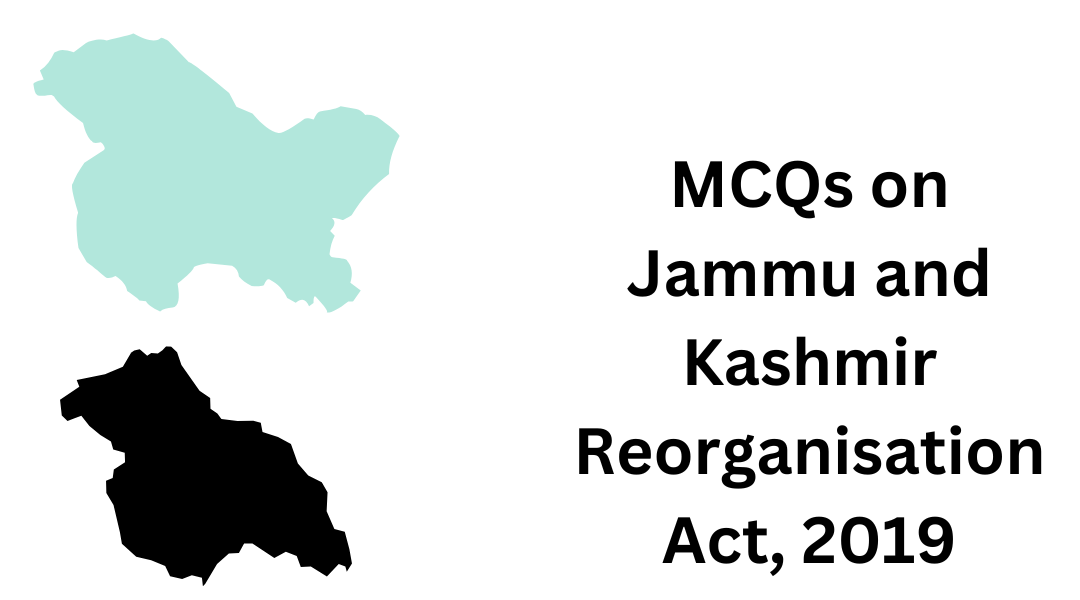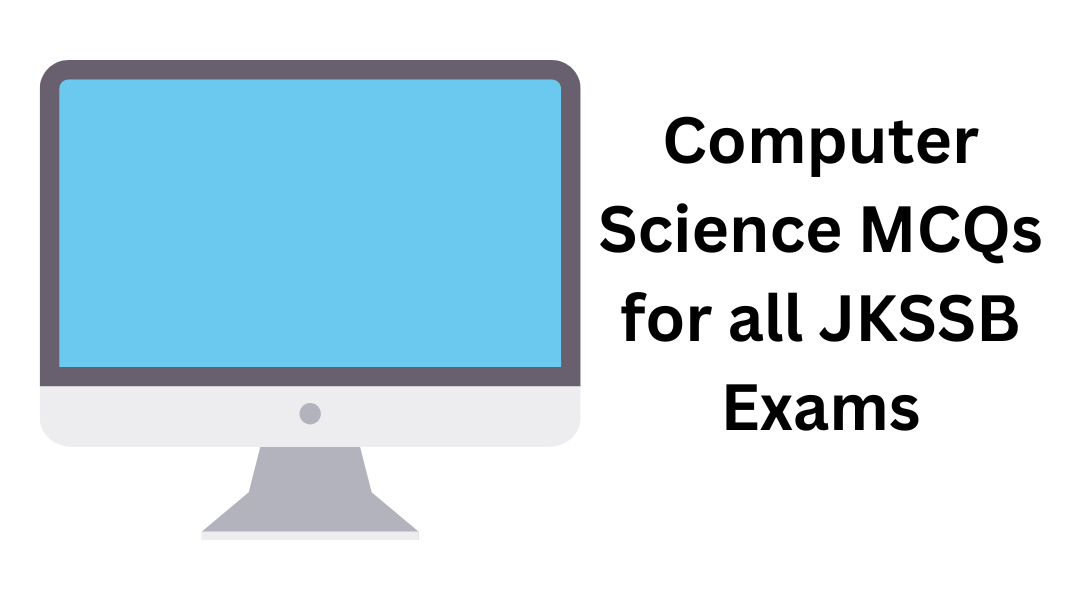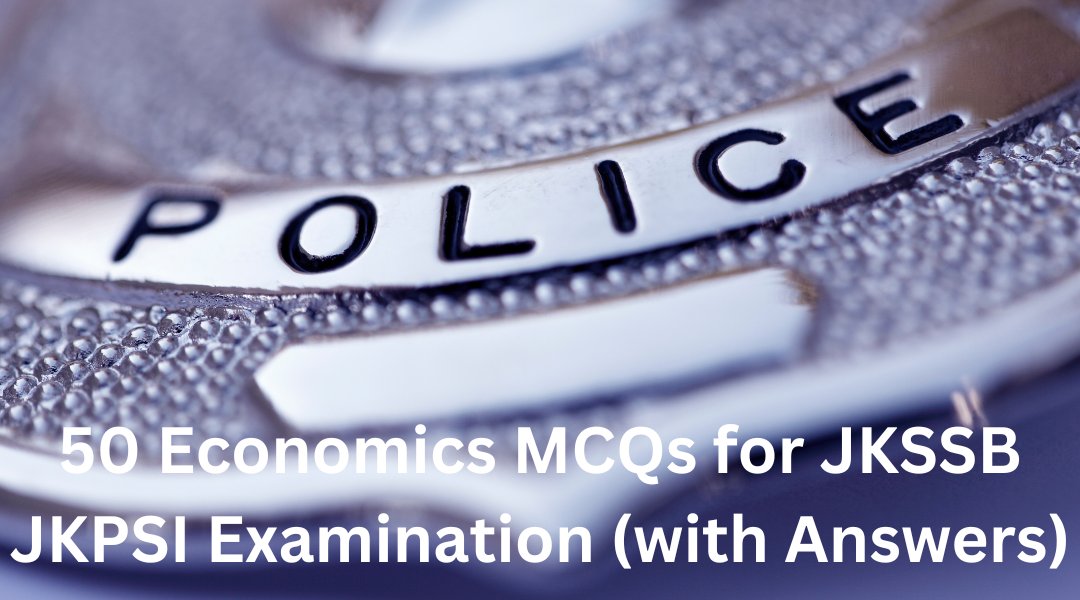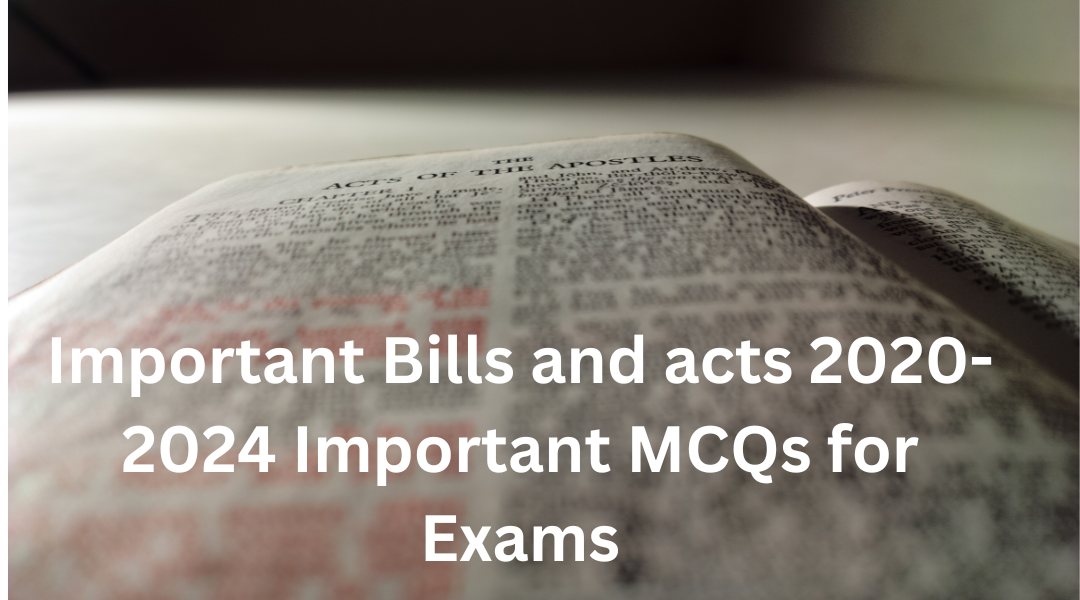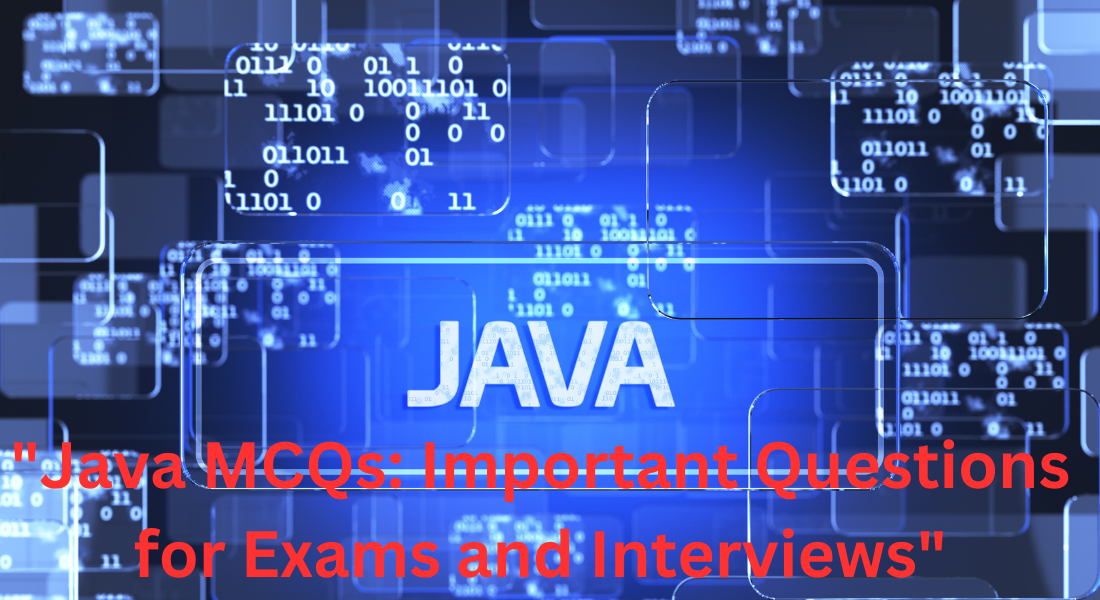Computer MCQs are essential for preparing for JKSSB exams, offering comprehensive coverage of topics like computer fundamentals, software, hardware and networking. These questions help improve technical knowledge, problem-solving skills and exam readiness. Practicing computer MCQs ensures a strong grasp of key concepts, boosting confidence and enhancing performance in competitive exams.
Here are 100 JKSSB MCQs on Computers with answers and 20-word explanations for each:
1. What is the brain of the computer?
a. ALU
b. Memory
c. CPU
d. Control Unit
Answer: c
Explanation: The CPU (Central Processing Unit) is often called the brain of the computer because it processes data and instructions.
2. Which of the following is the smallest unit of data in a computer?
a. Bit
b. Byte
c. Nibble
d. Kilobyte
Answer: a
Explanation: A bit is the smallest unit of data in a computer and represents either 0 or 1 in binary.
3. Which of the following is a non-volatile memory?
a. RAM
b. ROM
c. Cache
d. Register
Answer: b
Explanation: ROM (Read Only Memory) retains data even when the computer is turned off, unlike RAM which is volatile memory.
4. Which type of software controls the overall operation of a computer?
a. Application software
b. Operating system
c. Utility software
d. Firmware
Answer: b
Explanation: The operating system manages hardware and software resources, controlling basic operations like memory, processing, and storage.
5. Which of the following is not an input device?
a. Keyboard
b. Mouse
c. Monitor
d. Scanner
Answer: c
Explanation: A monitor is an output device that displays information. Input devices are used to provide data to the computer.
6. What is the full form of RAM?
a. Random Access Memory
b. Read Access Memory
c. Read And Maintain
d. Read Application Module
Answer: a
Explanation: RAM (Random Access Memory) is temporary storage that holds data and applications while the computer is in use.
7. What is a binary number system composed of?
a. 0 and 1
b. 2 and 3
c. 1 and 2
d. 0 and 2
Answer: a
Explanation: The binary system, essential in computing, consists of two digits: 0 and 1, representing the simplest form of data.
8. Which of the following is an example of an operating system?
a. MS Word
b. Windows
c. Oracle
d. Google Chrome
Answer: b
Explanation: Windows is a popular operating system used to manage and operate a computer, unlike applications like MS Word or browsers.
9. Which of the following is used to connect to the Internet?
a. CPU
b. Modem
c. Printer
d. Scanner
Answer: b
Explanation: A modem is a device that connects a computer to the internet by modulating and demodulating data signals.
10. Which of the following is a portable computer?
a. Desktop
b. Laptop
c. Server
d. Mainframe
Answer: b
Explanation: A laptop is a portable computer designed for easy mobility, whereas desktops and servers are stationary devices.
Read More MCQs of History for JKSSB JKPSI Exam
11. What does GUI stand for?
a. Graphical User Interface
b. General User Interface
c. Graph User Input
d. Great User Interface
Answer: a
Explanation: GUI (Graphical User Interface) allows users to interact with electronic devices through graphical icons instead of text commands.
12. What is the permanent memory in your computer called?
a. RAM
b. Cache
c. Hard Disk
d. ROM
Answer: d
Explanation: ROM (Read-Only Memory) is permanent memory that stores critical instructions necessary for the system’s basic functioning.
13. Which of the following is an output device?
a. Mouse
b. Keyboard
c. Printer
d. Scanner
Answer: c
Explanation: A printer is an output device that converts digital data into printed documents, whereas keyboards and mice are input devices.
14. Which of the following is an example of application software?
a. Windows
b. Linux
c. MS Word
d. BIOS
Answer: c
Explanation: MS Word is application software used for word processing, while Windows and Linux are operating systems.
15. What does HTTP stand for?
a. Hyper Text Transfer Protocol
b. Hyper Text Transmission Protocol
c. High Transfer Text Protocol
d. Hyper Text Transfer Procedure
Answer: a
Explanation: HTTP (Hyper Text Transfer Protocol) is the foundation of data communication on the web, enabling the transfer of web pages.
16. Which company developed the first mechanical computer?
a. Apple
b. IBM
c. Microsoft
d. Charles Babbage
Answer: d
Explanation: Charles Babbage is credited with developing the first mechanical computer, known as the Analytical Engine.
17. What is the shortcut key for copying text in Windows?
a. Ctrl + C
b. Ctrl + V
c. Ctrl + X
d. Ctrl + Z
Answer: a
Explanation: Ctrl + C is the universal shortcut key for copying selected text or files in the Windows operating system.
18. Which of the following is used for storing data permanently?
a. RAM
b. Cache
c. Hard Disk
d. CPU
Answer: c
Explanation: A hard disk is used to store data permanently, unlike RAM, which stores data temporarily for processing.
19. What does URL stand for?
a. Universal Resource Locator
b. Uniform Resource Locator
c. Unique Resource Locator
d. Unified Resource Locator
Answer: b
Explanation: URL (Uniform Resource Locator) is the address used to access resources on the Internet, like websites or files.
20. What is the full form of USB?
a. Universal Serial Bus
b. Universal System Bus
c. Unified Serial Bus
d. Unique Serial Bus
Answer: a
Explanation: USB (Universal Serial Bus) is a standard connection interface for devices such as keyboards, mice, and storage devices.
21. Which of the following is a temporary storage area?
a. ROM
b. RAM
c. Hard Disk
d. CD
Answer: b
Explanation: RAM (Random Access Memory) is temporary storage used by the computer to store data while a task is being performed.
22. What is the full form of LAN?
a. Local Access Network
b. Local Area Network
c. Large Area Network
d. Low Access Network
Answer: b
Explanation: LAN (Local Area Network) connects computers in a small geographical area, like an office or home, enabling communication between devices.
23. What is the main function of a computer’s BIOS?
a. Manage hardware
b. Store data
c. Boot the system
d. Control memory
Answer: c
Explanation: BIOS (Basic Input/Output System) initializes the computer during startup and manages data flow between the operating system and hardware.
24. What is the main function of an ALU?
a. Store data
b. Perform arithmetic and logic operations
c. Control input/output
d. Manage memory
Answer: b
Explanation: The Arithmetic Logic Unit (ALU) performs all arithmetic and logical operations, including addition, subtraction, and comparisons.
25. Which part of the computer helps to store temporary data?
a. RAM
b. ROM
c. CPU
d. Hard Disk
Answer: a
Explanation: RAM stores temporary data needed for running applications, unlike ROM or hard disks, which store permanent data.
26. Which of the following allows multiple devices to communicate over a network?
a. Router
b. Monitor
c. Keyboard
d. Printer
Answer: a
Explanation: A router directs traffic between multiple devices on a network, enabling them to communicate and share resources.
27. Which key combination is used to paste data in Windows?
a. Ctrl + P
b. Ctrl + V
c. Ctrl + C
d. Ctrl + X
Answer: b
Explanation: Ctrl + V is the universal shortcut key used for pasting copied or cut content into the desired location.
28. What is the name of the temporary storage that helps speed up computer tasks?
a. Cache
b. RAM
c. ROM
d. Hard Disk
Answer: a
Explanation: Cache is a smaller, faster type of memory used by the CPU to quickly access frequently used data.
29. Which of the following is considered the first computer programmer?
a. Ada Lovelace
b. Alan Turing
c. Charles Babbage
d. Tim Berners-Lee
Answer: a
Explanation: Ada Lovelace is often regarded as the first computer programmer for her work on Charles Babbage’s Analytical Engine.
30. Which type of malware replicates itself to spread to other computers?
a. Virus
b. Trojan
c. Worm
d. Spyware
Answer: c
Explanation: A worm is malware that self-replicates and spreads across networks without needing to attach itself to other programs.
Here are the remaining 70 JKSSB MCQs on Computers with answers and 20-word explanations:
31. What is phishing?
a. A fishing technique
b. Fraudulent attempts to obtain sensitive information
c. Virus spreading
d. Data encryption
Answer: b
Explanation: Phishing refers to fraudulent activities to steal sensitive data like usernames, passwords, and credit card details by disguising as a trustworthy entity.
32. Which of the following is an example of system software?
a. Google Chrome
b. MS Word
c. Windows
d. Excel
Answer: c
Explanation: System software, like Windows, manages hardware and basic operations of the computer, while Chrome and Word are application software.
33. What is the default file extension for MS Word documents?
a. .doc
b. .xls
c. .ppt
d. .txt
Answer: a
Explanation: MS Word documents are saved with the file extension .doc (older versions) or .docx (modern versions).
34. What type of device is a light pen?
a. Input device
b. Output device
c. Storage device
d. Processing device
Answer: a
Explanation: A light pen is an input device used to select objects on a screen by detecting light.
35. Which key is used to refresh a webpage in most browsers?
a. F1
b. F5
c. F10
d. F12
Answer: b
Explanation: F5 is commonly used as the shortcut key to refresh or reload a webpage in most web browsers.
36. Which of the following is a type of display screen?
a. OLED
b. SSD
c. RAM
d. CPU
Answer: a
Explanation: OLED (Organic Light Emitting Diode) is a type of display screen used in modern TVs and smartphones for brighter and more vivid images.
37. What is the function of the Control Unit in the CPU?
a. Performs arithmetic operations
b. Controls input/output devices
c. Manages memory
d. Controls the execution of instructions
Answer: d
Explanation: The Control Unit directs and controls the execution of instructions within the CPU, coordinating operations between components.
38. What is the full form of Wi-Fi?
a. Wireless Fidelity
b. Wired Fidelity
c. Wide Fidelity
d. Wireless Fiber
Answer: a
Explanation: Wi-Fi (Wireless Fidelity) is a technology that allows devices to connect to a network wirelessly using radio waves.
39. What is the main purpose of antivirus software?
a. Improve performance
b. Protect against malware
c. Defragment hard drive
d. Increase internet speed
Answer: b
Explanation: Antivirus software is designed to detect, prevent, and remove malicious software (malware) like viruses, worms, and Trojans from the computer.
40. What does PDF stand for?
a. Portable Document Format
b. Print Document File
c. Programmed Data File
d. Processed Document File
Answer: a
Explanation: PDF (Portable Document Format) is a widely used file format developed by Adobe for documents that maintain their layout across platforms.
41. Which device is used to connect a computer to a network?
a. Scanner
b. Router
c. Projector
d. Mouse
Answer: b
Explanation: A router is a device that connects computers and other devices to a network, allowing them to communicate and share data.
42. Which of the following is an example of a search engine?
a. Yahoo
b. WordPress
c. PowerPoint
d. Skype
Answer: a
Explanation: Yahoo is a search engine used to find information on the internet, while WordPress is a content management system.
43. Which key is used to move to the beginning of a document?
a. Ctrl + End
b. Home
c. Ctrl + Home
d. End
Answer: c
Explanation: Pressing Ctrl + Home moves the cursor to the beginning of a document, while Ctrl + End moves it to the end.
44. What is the main purpose of a firewall?
a. Prevent unauthorized access
b. Increase processing speed
c. Improve display quality
d. Optimize memory usage
Answer: a
Explanation: A firewall is a security system that monitors and controls incoming and outgoing network traffic to prevent unauthorized access.
45. What is the full form of DNS?
a. Domain Name System
b. Data Network Service
c. Domain Network System
d. Data Name System
Answer: a
Explanation: DNS (Domain Name System) translates domain names like www.example.com into IP addresses, enabling computers to locate websites.
46. What is the full form of CPU?
a. Central Processing Unit
b. Computer Processing Unit
c. Control Processing Unit
d. Core Processing Unit
Answer: a
Explanation: The CPU (Central Processing Unit) is the primary component of a computer that performs most of the processing inside a computer.
47. Which of the following is used for creating presentations?
a. MS Excel
b. MS PowerPoint
c. MS Access
d. MS Word
Answer: b
Explanation: MS PowerPoint is software used for creating presentations with slides, animations, and multimedia elements.
48. Which of the following is an optical storage device?
a. SSD
b. CD
c. RAM
d. USB
Answer: b
Explanation: A CD (Compact Disc) is an optical storage device used to store data, music, or software in digital format.
49. What is the purpose of a UPS?
a. Increase processing speed
b. Store files
c. Provide power backup
d. Connect to the internet
Answer: c
Explanation: A UPS (Uninterruptible Power Supply) provides backup power to a computer during power outages, preventing data loss.
50. Which programming language is known as the language of the web?
a. C++
b. Python
c. HTML
d. Java
Answer: c
Explanation: HTML (HyperText Markup Language) is the standard language used to create web pages and web applications.
51. What is cloud computing?
a. Computing done via satellites
b. Storing and accessing data over the internet
c. Weather forecasting software
d. Operating systems on virtual machines
Answer: b
Explanation: Cloud computing allows users to store and access data and services over the internet, rather than on local storage.
52. Which of the following is used to input sound into a computer?
a. Microphone
b. Speaker
c. Monitor
d. Headphone
Answer: a
Explanation: A microphone is an input device that converts sound into electrical signals for processing or storage on a computer.
53. What is the full form of URL?
a. Uniform Resource Locator
b. Uniform Retrieval Link
c. Universal Resource Locator
d. Unified Retrieval Locator
Answer: a
Explanation: A URL (Uniform Resource Locator) is the address used to access resources like websites or files on the internet.
54. Which of the following is an operating system?
a. Microsoft Edge
b. Android
c. MS Paint
d. Python
Answer: b
Explanation: Android is an operating system for mobile devices, managing hardware resources and running applications, unlike Python or MS Paint.
55. What does the term “booting” refer to?
a. Installing software
b. Turning on the computer
c. Accessing files
d. Executing programs
Answer: b
Explanation: Booting is the process of starting or restarting a computer, during which the operating system is loaded into the computer’s memory.
56. Which of the following is not a type of printer?
a. Laser
b. Inkjet
c. Dot matrix
d. Magnetic tape
Answer: d
Explanation: Magnetic tape is a storage device, whereas laser, inkjet, and dot matrix are different types of printers used for printing documents.
57. What is the full form of HTTP?
a. Hyper Text Transfer Protocol
b. High Text Transfer Protocol
c. Hyper Text Transmission Protocol
d. High Transmission Text Protocol
Answer: a
Explanation: HTTP (HyperText Transfer Protocol) is used for transmitting web pages and data on the internet.
58. What does SSD stand for?
a. Solid State Drive
b. Small Storage Device
c. Simple State Device
d. Secure Storage Device
Answer: a
Explanation: SSD (Solid State Drive) is a fast storage device that uses flash memory to store data instead of spinning disks.
59. Which of the following allows you to view the content of a file?
a. Notepad
b. MS Word
c. VLC Media Player
d. All of the above
Answer: d
Explanation: Notepad, MS Word, and VLC Media Player can all be used to view the content of different types of files.
60. What is a modem used for?
a. Increasing processing speed
b. Providing power backup
c. Connecting to the internet
d. Storing data
Answer: c
Explanation: A
modem modulates and demodulates signals for connecting computers to the internet, enabling data transmission over telephone lines or cables.
Here are the remaining 40 JKSSB MCQs on Computers with answers and explanations:
61. What is the function of the RAM in a computer?
a. Permanent storage
b. Temporary storage
c. Power backup
d. Data encryption
Answer: b
Explanation: RAM (Random Access Memory) provides temporary storage that allows programs to run quickly by storing data needed by the CPU.
62. What is the main use of a spreadsheet program like MS Excel?
a. Writing documents
b. Editing photos
c. Performing calculations and data analysis
d. Playing videos
Answer: c
Explanation: A spreadsheet program like MS Excel is primarily used for performing calculations, creating charts, and analyzing data.
63. Which programming language is best known for developing web applications?
a. COBOL
b. HTML
c. JavaScript
d. Fortran
Answer: c
Explanation: JavaScript is a popular programming language used to create dynamic and interactive elements on web pages.
64. What does GUI stand for?
a. Graphical User Interface
b. General User Interface
c. Group User Interface
d. Global User Interface
Answer: a
Explanation: GUI (Graphical User Interface) allows users to interact with a computer using icons and visual indicators instead of text commands.
65. What does a file extension represent?
a. File size
b. File location
c. File type
d. File permissions
Answer: c
Explanation: A file extension is a suffix attached to a file name that indicates the file type, such as .docx, .png, or .mp3.
66. Which of the following is a non-volatile memory?
a. RAM
b. Cache memory
c. ROM
d. Registers
Answer: c
Explanation: ROM (Read-Only Memory) is non-volatile, meaning it retains data even when the computer is turned off, unlike RAM.
67. What is the full form of BIOS?
a. Basic Input Output System
b. Binary Input Output System
c. Basic Internal Operating System
d. Basic Integrated Output System
Answer: a
Explanation: BIOS (Basic Input Output System) initializes and tests hardware components when a computer is powered on.
68. Which one is an example of an optical disk?
a. SSD
b. USB
c. Blu-ray
d. Hard disk
Answer: c
Explanation: Blu-ray is an optical disk format used to store high-definition video and data, read using a laser.
69. What is the purpose of a web browser?
a. To create websites
b. To store data
c. To view and interact with web content
d. To manage emails
Answer: c
Explanation: A web browser allows users to view, navigate, and interact with content on the internet, including websites and multimedia.
70. What is the shortcut for ‘undo’ in most applications?
a. Ctrl + U
b. Ctrl + Z
c. Ctrl + Y
d. Ctrl + X
Answer: b
Explanation: Ctrl + Z is the standard keyboard shortcut used to undo the last action in most applications.
71. What is a computer network?
a. Collection of computers that share resources
b. A single computer
c. Only hardware devices
d. Only software
Answer: a
Explanation: A computer network is a collection of computers and devices that share resources, such as files, printers, and internet connections.
72. What does HTML stand for?
a. HyperText Markup Language
b. HighText Markup Language
c. HyperTool Markup Language
d. High Transfer Machine Language
Answer: a
Explanation: HTML (HyperText Markup Language) is the standard language used for creating and designing web pages.
73. What is the function of the task manager in Windows?
a. Manage tasks and performance
b. Create new tasks
c. Change wallpaper
d. Update software
Answer: a
Explanation: The task manager in Windows is used to monitor system performance and manage running tasks, processes, and applications.
74. Which of the following is not a search engine?
a. Google
b. Bing
c. Firefox
d. DuckDuckGo
Answer: c
Explanation: Firefox is a web browser, not a search engine. Google, Bing, and DuckDuckGo are search engines used for finding information online.
75. What is an IP address?
a. A physical address
b. A numeric label assigned to devices on a network
c. An email address
d. A device name
Answer: b
Explanation: An IP address (Internet Protocol address) is a unique identifier assigned to devices on a network for communication.
76. Which protocol is used to send emails?
a. FTP
b. SMTP
c. HTTP
d. IP
Answer: b
Explanation: SMTP (Simple Mail Transfer Protocol) is used to send emails between servers and email clients over the internet.
77. What is the main function of an operating system?
a. Control hardware and software resources
b. Perform arithmetic operations
c. Run only applications
d. Save files
Answer: a
Explanation: An operating system (OS) controls and manages hardware and software resources, providing a platform for running applications.
78. What is the term for unauthorized access to data?
a. Phishing
b. Hacking
c. Data backup
d. Malware
Answer: b
Explanation: Hacking refers to unauthorized access to data or systems, often with the intention of stealing or manipulating information.
79. What is a URL?
a. Uniform Resource Locator
b. Unified Real Link
c. Unique Reference Label
d. Universal Retrieval List
Answer: a
Explanation: A URL (Uniform Resource Locator) is the address of a resource, such as a webpage, on the internet.
80. What does the term “boot” refer to in computing?
a. Turning off the computer
b. Restarting the computer
c. Starting up the computer
d. Shutting down the computer
Answer: c
Explanation: Booting refers to starting up a computer, during which the operating system and hardware are initialized.
81. Which of the following is a valid email domain?
a. .com
b. .ftp
c. .sys
d. .doc
Answer: a
Explanation: .com is a common top-level domain used in email addresses, while others are not valid domain extensions for emails.
82. What is the main function of an ALU (Arithmetic Logic Unit)?
a. Perform logical and arithmetic operations
b. Store data
c. Control output devices
d. Process graphics
Answer: a
Explanation: The ALU (Arithmetic Logic Unit) performs arithmetic and logical operations within the CPU, such as addition, subtraction, and comparisons.
83. What is spyware?
a. A type of virus
b. A security software
c. A software that collects user data secretly
d. A hardware device
Answer: c
Explanation: Spyware is a type of malicious software that secretly collects data from a user’s device without their consent.
84. What is the main use of a compiler?
a. Translate high-level code into machine code
b. Create images
c. Store data
d. Perform calculations
Answer: a
Explanation: A compiler translates high-level programming languages like C++ or Java into machine code that a computer’s hardware can execute.
85. What is the default extension for an Excel file?
a. .docx
b. .ppt
c. .xls
d. .txt
Answer: c
Explanation: The default file extension for MS Excel is .xls (older versions) or .xlsx (modern versions), representing spreadsheet files.
86. Which device is considered the “brain” of a computer?
a. Hard drive
b. Monitor
c. CPU
d. Mouse
Answer: c
Explanation: The CPU (Central Processing Unit) is referred to as the “brain” of the computer because it processes data and executes instructions.
87. What is an example of an input device?
a. Printer
b. Monitor
c. Keyboard
d. Speaker
Answer: c
Explanation: A keyboard is an input device used to input data and commands into a computer, while printers and monitors are output devices.
88. What does “Ctrl + C” do in most applications?
a. Cut text
b. Copy text
c. Paste text
d. Close application
Answer: b
Explanation: “Ctrl + C” is a keyboard shortcut used to copy the selected text or content to the clipboard in most applications.
89. What is malware?
a. Malicious software
b. A type of hardware
c. System security
d. A programming language
Answer: a
Explanation: Malware (malicious software) refers to software designed to harm or exploit any device or network, including viruses, Trojans, and worms.
90. What is the primary use of a USB port?
a. Store data
b. Connect peripheral devices
c. Display output
d. Process images
Answer: b
Explanation: A USB (Universal Serial Bus) port is used to connect peripheral devices like keyboards, mice, and external storage devices to a computer.
91. What is the function of a firewall in a computer network?
a. Speed up the internet
b. Block unauthorized access
c. Manage files
d. Control printer settings
Answer: b
Explanation: A firewall is a security system that monitors and controls incoming and outgoing network traffic to block unauthorized access.
92. What is cloud storage?
a. Storing data on local disks
b. Storing data on remote servers accessible via the internet
c. Backup data using CDs
d. Saving data temporarily
Answer: b
Explanation: Cloud storage allows users to store data on remote servers and access it through the internet, offering convenience and scalability.
93. Which of the following is an example of system software?
a. Microsoft Word
b. Windows 10
c. Photoshop
d. VLC Media Player
Answer: b
Explanation: Windows 10 is an operating system, which is a type of system software that manages hardware and software resources on a computer.
94. What does FTP stand for?
a. File Transfer Protocol
b. Fast Transfer Process
c. File Text Processor
d. File Temporary Protocol
Answer: a
Explanation: FTP (File Transfer Protocol) is a standard network protocol used to transfer files between a client and server over the internet.
95. What is the purpose of a computer virus?
a. To protect data
b. To infect and damage files or systems
c. To enhance performance
d. To back up files
Answer: b
Explanation: A computer virus is malicious software designed to replicate itself and cause harm to files, systems, or networks.
96. What is the most common method to secure a Wi-Fi network?
a. Use WPA or WPA2 encryption
b. Disable network access
c. Install antivirus
d. Increase speed
Answer: a
Explanation: WPA (Wi-Fi Protected Access) or WPA2 encryption is used to secure wireless networks, preventing unauthorized access to data.
97. What is a data packet in networking?
a. A piece of data sent over a network
b. A backup file
c. A compressed folder
d. A program error
Answer: a
Explanation: A data packet is a small unit of data transmitted over a network, containing both the data and necessary metadata for delivery.
98. What is the function of a graphics card?
a. Store files
b. Render images and videos
c. Play audio
d. Manage input devices
Answer: b
Explanation: A graphics card, also known as a GPU, is responsible for rendering images, videos, and animations for display on a monitor.
99. What is the use of the ‘ping’ command in networking?
a. Measure network latency
b. Encrypt data
c. Share files
d. Manage network security
Answer: a
Explanation: The ‘ping’ command is used to test the connectivity between two devices on a network by measuring the time it takes for a data packet to travel.
100. What does SSD stand for?
a. Solid-State Drive
b. Software System Device
c. Secure Storage Data
d. System Security Disk
Answer: a
Explanation: SSD (Solid-State Drive) is a storage device that uses flash memory to store data, providing faster access speeds than traditional hard drives.
This completes the set of 100 JKSSB MCQs on computers with answers and explanations. Would you like to create a downloadable file for this set?

Asif Iqbal Wani is a professional content writer with over 5 years of experience in the education niche. With a speciality for content creation that’s thought-provoking and engaging, Arun specializes in making study guides and resources for exams and curriculum-based content.
With a zeal for learning, Asif comes across as a vibrant educator who simplifies the most difficult concepts into information that is easily digested, enabling learners to achieve success academically. His commitment to accuracy and creativity ensures that every piece of content not only teaches but also inspires.
Asif is committed to providing high-quality impactful content that works well for different student and faculty requirements.

